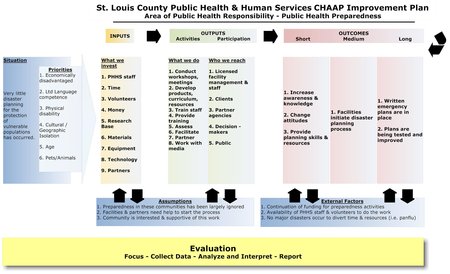Tools and Training
Logic Model
Variation: Line of sight model
On this page:
How to create a logic model
Examples of logic models
A logic model is a map or simple illustration of what you and your organization do, why you do it, what you hope to achieve, and how you will measure achievement. Logic models illustrate how a project, program, or policy is understood or intended to produce particular results.
"Line of sight" refers to a worker or team member's ability to identify their work with the overall objectives of the organization--to "see" the organization's goal at the end of their work.
How to create a logic model
For a step-by-step guide to creating logic models, you might find the following resources useful:
Logic Model Development Guide
WK Kellogg Foundation
Developing a Logic Model: Teaching and Training Guide (PDF)
University of Wisconsin Extension Service
Example logic model
Protecting Vulnerable Populations during Disasters (click to view larger)
St. Louis County Public Health and Human Services
